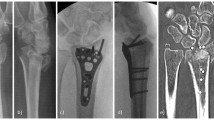Abstract
Osteoporosis is a skeletal disorder characterized by compromised bone strength predisposing to an increased risk of fracture. The most frequent sites of fragility fractures are the hip, the distal radius, the spine, the proximal humerus, and the ankle. In most cases, a surgical approach with subsequent rehabilitative treatment is required. The general aims of rehabilitation are to increase functioning and improve patients’ activities, participation level, and quality of life.
Similar content being viewed by others
References
(2001) NIH consensus development panel on osteoporosis. JAMA 285:785–795
Kanis JA, Burlet N, Cooper C, Delmas PD, Reginster JY, Borgstrom F, Rizzoli R, European Society for Clinical and Economic Aspects of Osteoporosis and Osteoarthritis (ESCEO) (2008) European guidance for the diagnosis and management of osteoporosis in postmenopausal women. Osteoporos Int 19:399–428
Cieza A, Schwarzkopf S, Sigl T, Stucki G, Melvin J, Stoll T, Woolf A, Kostanjsek N, Walsh N (2004) ICF core sets for osteoporosis. J Rehabil Med (44 Suppl):81–86
Tarantino U, Capone A, Planta M, D’Arienzo M, Letizia Mauro G, Impagliazzo A, Formica A, Pallotta F, Patella V, Spinarelli A, Pazzaglia U, Zarattini G, Roselli M, Montanari G, Sessa G, Privitera M, Verdoia C, Corradini C, Feola M, Padolino A, Saturnino L, Scialdoni A, Rao C, Iolascon G, Brandi ML, Piscitelli P (2010) The incidence of hip, forearm, humeral, ankle, and vertebral fragility fractures in Italy: results from a 3-year multicenter study. Arthr Res Ther 12(6):R226
Parker MJ, Handoll HHG (2006) Replacement arthroplasty versus internal fixation for extracapsular hip fractures in adults. Cochrane Database Syst Rev 2 Art. No.: CD000086. doi: 10.1002/14651858.CD000086.pub2
Pietri M, Lucarini S (2007) The orthopaedic treatment of fragility fractures. Clin Cases Miner Bone Metab 4(2):108–116
Meyer HE, Tverdal A, Falch JA, Pedersen JI (2000) Factors associated with mortality after hip fracture. Osteoporos Int 11(3):228–232
Hagsten B, Svensson O, Gardulf A (2006) Health-related quality of life and self-reported ability concerning ADL and IADL after hip fracture: a randomized trial. Acta Orthop 77(1):114–119
Di Monaco M, Vallero F, Di Monaco R, Tappero R, Cavanna A (2006) Muscle mass and functional recovery in women with hip fracture. Am J Phys Med Rehabil 85(3):209–215
Zimmerman S, Hawkes WG, Hebel JR, Fox KM, Lydick E, Magaziner J (2006) The lower extremity gain scale: a performance-based measure to assess recovery after hip fracture. Arch Phys Med Rehabil 87(3):430–436
Latham NK, Jette DU, Warren RL, Wirtalla C (2006) Pattern of functional change during rehabilitation of patients with hip fracture. Arch Phys Med Rehabil 87(1):111–116
Patterson BM, Cornell CN, Carbone B, Levine B, Chapman D (1992) Protein depletion and metabolic stress in elderly patients who have a fracture of the hip. J Bone Jt Surg Am 74(2):251–260
Iolascon G, Cervone M, Gimigliano R, Di Pietro G, Gimigliano F (2011) Neuropsychiatric disorders in hip fracture. Clin Cases Miner Bone Metab 8(3):49–53
Munin MC, Rudy TE, Glynn NW, Crossett LS, Rubash HE (1998) Early inpatient rehabilitation after elective hip and knee arthroplasty. JAMA 279(11):847–852
Chilov M, Cameron ID, March LM (2003) Evidence-based guidelines for fixing broken hips: an update. Med J Aust 179:489–492
Scottish Intercollegiate Guidelines Network (2002) Prevention and management of hip fracture in older people. A national clinical guideline. Scottish Intercollegiate Guidelines Network, Edinburgh. Guideline 71. http://www.sign.ac.uk/guidelines/fulltext/71/index.html. Accessed 31 May 2013
Bonner FJ Jr, Sinaki M, Grabois M, Shipp KM, Lane JM, Lindsay R, Gold DT, Cosman F, Bouxsein ML, Weinstein JN, Gallagher RM, Melton LJ III, Salcido RS, Gordon SL (2003) Health professional’s guide to rehabilitation of the patient with osteoporosis. Osteoporos Int 14(Suppl 2):S1-22
Scioscia TN, Ziran BH (2003) Use of a vertical transarticular pin for stabilization of severe ankle fractures. Am J Orthop 32:46–48
Conflict of interest
None
Author information
Authors and Affiliations
Corresponding author
Rights and permissions
About this article
Cite this article
Gimigliano, F., Iolascon, G., Riccio, I. et al. Post-surgical rehabilitative approach to fragility fractures. Aging Clin Exp Res 25 (Suppl 1), 23–25 (2013). https://doi.org/10.1007/s40520-013-0094-x
Received:
Accepted:
Published:
Issue Date:
DOI: https://doi.org/10.1007/s40520-013-0094-x




